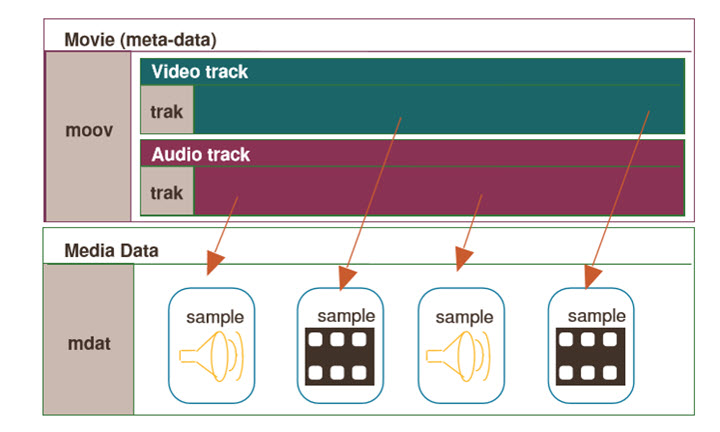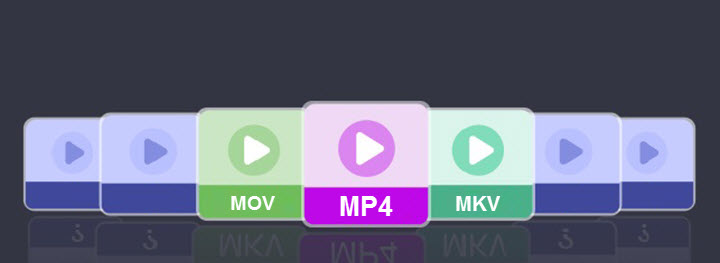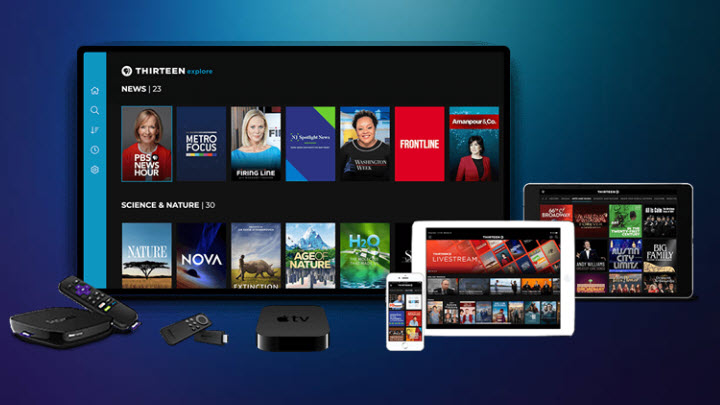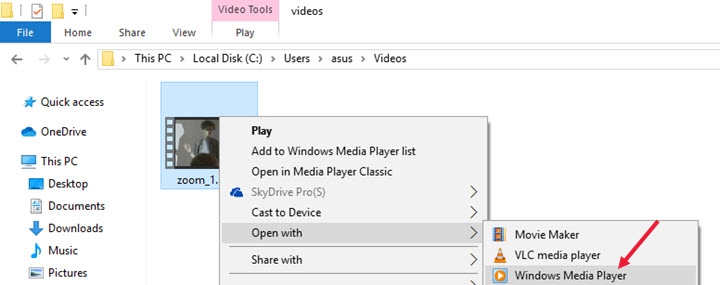MP4 seems like the most popular video format used everywhere in our digital life. You might see videos stored in .mp4 files from digital cameras, smartphones, online video platforms, and so forth. But do you know what MP4 is on earth? Why it is so popular?
In this post, we will introduce MP4 file format from its features, specifications, history, advantages, disadvantages, and the differences between MP4 and other formats. With a better understanding of MP4 file format, you can play, edit, and share MP4 files without any trouble. Let's get started.
What Is MP4
MP4, aka MPEG-4 Part 14 (or ISO/IEC 14496-14), is the 14th part of the MPEG-4 standard that defines the container format for compressed digital audio and visual data. In addition to video and audio, the MP4 format container also holds still images and subtitles.
Simply put, MP4 acts like a wrapper around multimedia files and associated data that's necessary for playing the file correctly. But note that, MP4 stores data instead of compressing them, so it has to work with other codecs, for example, H.264/AVC and HEVC for video, AAC, and MP3 for audio, and 3GPP Timed Text for subtitles.
MP4 File Extension
The official and the most common file extension for MP4 is .mp4. But since it can hold different types of multimedia files, it could come with various filename extensions as below:
- .mp4: The general MPEG-4 files that contain both video and audio.
- .m4a: MPEG-4 files with audio only and often found in Apple devices, e.g. iTunes music downloads and voice memos.
- .m4r: MPEG-4 audio used as Apple Ringtone.
- .m4p: MPEG-4 audio with copyright protection like Apple DRM.
- .m4v: MPEG-4 Visual bitstreams and sometimes standing for the video stream in MP4 file.
- .m4b: MPEG-4 audio format container for audiobooks and podcasts.
Brief History of MP4
MP4 was standardized by the Motion Picture Experts Group (MPEG), an alliance of working groups established jointly by ISO and IEC. It was initially developed to hold low-data video and audio files for streaming over the internet. And it has gone through several revisions since its birth.
In 2001, the first version of the MP4 file format was created based on the QuickTime format specification and published as a revision of the MPEG-4 Part 1: Systems.
In 2003, it was revised into MPEG-4 Part 14 (ISO/IEC 14496-14:2003) and is commonly known as MP4 file format version 2.
In 2004, MP4 was generalized into the ISO Base Media File Format (ISO BMFF) and used for defining the structure for time-based media files. As a result, it becomes the basis of many file formats from the MPEG-4 family, like say, 3GP.
MP4 File Structure
The data in an MP4 file is mainly divided into two segments – media data and metadata. The media data includes streams of video, audio, and subtitles. While metadata indicates the flags for timestamps, random access, and so forth.
Each data in MP4 is stored in a basic structure called atom or box and no data is outside a box.

Root level boxes in an MP4 file:
- ftyp: Stores information about the file type, description, and the common data structures used.
- moov: Holds all the movie metadata.
- mdat: Contains media data.
- moof: Contains video fragments.
- pdin: Stores progressive video loading/downloading information.
- mfra: Contains random access to video fragments
- stts: Indicates the sample-to-time table.
- stsc: Indicates the sample-to-chunk table.
- stsz: Presents sample sizes (framing).
Second-level boxes in an MP4 file:
- mvhd: Holds the video header information with full details of the video.
- trak: Represents individual tracks.
- udta: Holds the user and track information.
- iods: MP4 file descriptor.
Note: After parsing an MP4 file, you might find some atoms are missing, compared to the lists above. That's because, as opposed to defining a strict structure for media files, MP4 allows custom structure and hierarchy for media of different types. Unknown boxes can be skipped syntactically and media data can be stored unstructured either in boxes (usually mdat or idat) under the corresponding root or in a separate file.
MP4 Advantages and Disadvantages
In the era where many file formats co-exist, MP4 hits a home run with its high compatibility. It gets widely native support on TVs, mobile phones, computers, multimedia software, and web browsers. But it's not perfect and comes with both excellent features and some drawbacks.
Advantages
- Versatility – MP4 is suitable for HTTP streaming, broadcasting, and editing.
- Less Quality Loss - MP4 can collaborate with many efficient codecs that achieve less quality loss and smaller file size. And it's expected to get further development along with future compression methods.
- Flexible Modification – Each data is kept independently so that users are allowed to extract audio and subtitles from MP4, remux MKV to MP4, etc.
- Extensible Application – Support for metadata means that the MP4 file can be integrated with many other user interaction features, e.g. navigation options, menus, 3D graphics, VR videos, etc.
Disadvantages
- Resource-intensive - MP4 processing needs lots of computing resources because a single MP4 file can contain various media data and metadata.
- Error-prone – The more data MP4 can hold, the more potential errors might happen, for example, MP4 file corruption, incompatible codecs, audio track invalid, a/v out of sync, etc.
Compare MP4 and Other Formats

MP4 vs MOV
MP4 and MOV are both video container format resembling in many aspects. But they were developed by different organizations. MOV is proprietary to Apple and came into being earlier than MP4. While MP4 was standardized by International Organization for Standardization.
MP4 used to be natively supported by more devices, programs, and video platforms. But now both of them are widely used. So you just need to convert MOV to MP4 or MP4 to MOV according to the recommended settings of the target platform or end device.
MP4 vs MKV
MKV, a royalty-free video format container, supports unlimited media tracks and is often used to store HD movies from Blu-ray discs and DVDs. While MP4 is patent-protected and has specific media content limit. Theoretically, MKV can be used by anyone for free, but MP4 is more popular. So you may need an MKV to MP4 converter to change the container if you want to post it on YouTube.
MP4 vs AVI
MP4 works with a number of media codecs, especially MPEG lineup. However, AVI prefers Xvid or DivX to encode videos. This makes AVI videos HD but take much more storage. AVI is well supported by Microsoft and Android devices, but missing on the format list of Apple devices and social media apps like Twitter and TikTok. To deal with legacy AVI videos easily, users have to convert AVI to MP4 with high quality retained.
MP4 vs MP3
MP3 and MP4 stores different media files in essence. MP3 is only used for audio, but MP4 can contain audio, video, images, and subtitles. And technically, MP3 is an audio coding format that determines how an audio file is compressed, whereas MP4 is a video container format that has nothing to do with coding schemes. MP4 wraps up multimedia files that have already been compressed, including MP3 audio.
What Devices Support MP4
MP4 has penetrated into every branch of the digital industry - video recording, broadcasting, streaming, editing, and beyond. Partly because MP4 is an international standard that breaks the barrier between multimedia products from different companies. And partly because it's a generous container. Aside from a broad spectrum of codecs, it also wraps videos with other technologies like 8K/4K, 10-bit HDR, Dolby Vision, 360-degree, 3D, VR, etc.

1. TV
Smart TV: HD and 4K smarts TV from Sony, Samsung, Panasonic, LG, and TCL support MP4 videos that you load via the USB port. Most modern TVs support MP4 with H.264/AVC and AAC and only a few brands support HEVC MP4.
TV box: The market is mainly shared by Apple TV and Android TV boxes. With a TV box connected via the HDMI port, you can watch streaming MP4 videos in VP8, VP9, H.264, or H.265 even on a non-smart TV. And what exactly kind of MP4 can be decoded depends on the player in the OS, but AVC/H.264 is the most universal codec used for MP4 videos on TV.
2. Portable Device
Apple devices: iPhone, iPad, iPod touch, MacBook Air, and MacBook Pro natively decode MP4 files with MPEG-4, MPEG-2, H.264, and HEVC videos, and MP3 and AAC audio tracks. But the MP4 encoders are limited to HEVC and H.264.
Android phones and tablets: Following the specs of Android OS media format, smartphones and tablets from Samsung, Pixel, Sony, Huawei, etc. were born with native support for MP4 H.264, HEVC, and MPEG-4. But only devices with Android 5.0 or above support HEVC 4K MP4.
Windows PC: MP4 files (MPEG-2, MPEG-4, H.264, VP8, and VP9) are well supported by PC with Windows 7, 8, 10, and 11. However, Windows 10 dropped the native support for MP4 HEVC. Now users need to install an HEVC codec so as to play MP4 on Windows 10/11 without error.
3. Game Console
Microsoft Xbox: Xbox 360 and Xbox One can play MP4 in MPEG-4 and H.264 with the built-in player Xbox Media Player. However, when MP4 works as the container, there are more restrictions on resolution and bitrates (1080p 10Mbps @30fps).
Sony PlayStation: PS3, PS4, and PS5 are compatible with MP4 H.264 and AAC only. But there are differences in the High Profile Level. PS4 won't play MP4 videos except they were decoded with H.264/MPEG-4 AVC High Profile Level 4.2.
4. DVD Player
Many DVD players today are designed with a UBS port via which you can load and import MP4 files. But whether you can play MP4 with DVD players successfully is further determined by the codec and resolution. DVD players like MEGATEK DP-260M55HD, MEGATEK DP-225M66HD, and NAVISKAUTO 12 support MP4 MPEG4 videos in a dimension of 720 x 480 or 720 x 576.
How to Open an MP4 File
Generally, the default media player will play it in no time when you double-click on a .mp4 file on your computer or tap the video on your iPhone, Android phone, or tablet. In addition to QuickTime Player and Windows Media Player, you can open MP4 videos with VLC media player, 5KPlayer, as well as MP4 video editors.

Though MP4 is widely supported, you may fail to open an MP4 video due to various factors. To troubleshoot MP4 cannot open errors, we summed up some methods as follows:
- Convert MP4: If the MP4 format container is not supported, convert MP4 to AVI, MOV, WMV, WebM, or other formats according to the requirements of the player or platform.
- Re-encode MP4: If the failure was caused by the video codec in the file, convert MP4 to H.264 or other popular video codecs.
- Install MP4 codec software: This method is only workable for Windows because there's no MP4 codec for Mac yet.
- Compress MP4: When an MP4 file is too large (e.g. a 1.2GB MP4 movie from DVD, or a 2GB 4K MP4 from an iPhone) while you are using a less capable player or processing it on a low-end computer, you can make it smaller with an MP4 compressor in advance.
- Repair MP4: MP4 files might be damaged in the process of recording or transferring, so the media player cannot index the data inside and play the video correctly. To fix such a problem, you need to repair MP4 files with a piece of professional software.
Frequently Asked Questions
What's the difference between MP4 and H.264?
MP4 is the 14th part of MPEG-4 that standardizes the way how to store media data and metadata. While H.264/AVC (Advanced Video Coding) is the 10th part of MPEG-4 and represents a standard for video coding. Namely, MP4 is used to store data, while H.264 is used to compress video data.
Is MP4 the best video format?
It depends. MP4 packs video and audio into a small size and is supported by most digital devices and platforms. But it's not always your best option when the codec is unsupported or other errors occur. So it's better to choose the best video format in terms of your specific needs for video processing, sharing, or playing.
Reference
[1] MPEG: https://www.mpeg.org/standards/MPEG-4/
[2] ISO: https://www.iso.org/standard/79110.html
[3] MP4 – Wikipedia: https://en.wikipedia.org/wiki/MPEG-4_Part_14







